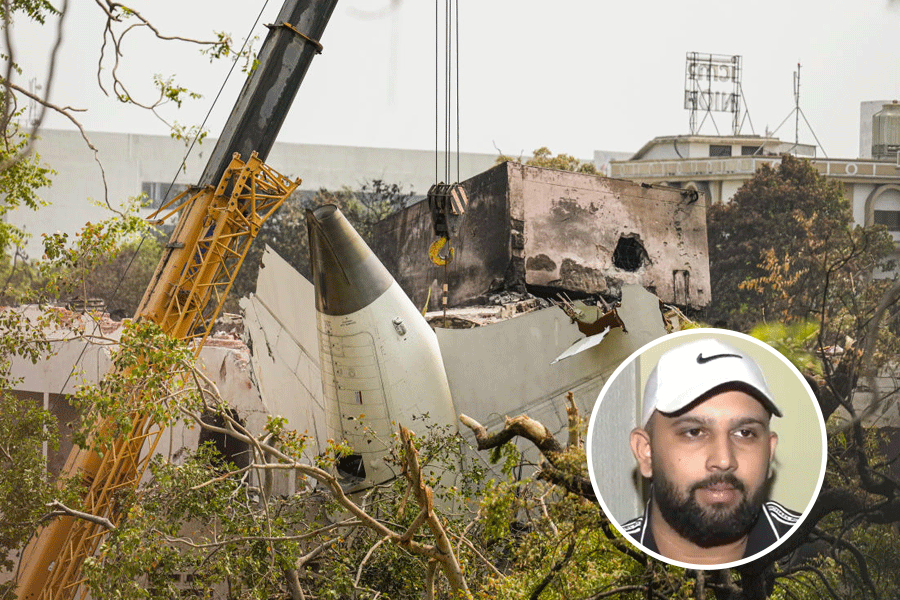 |
 |
| Photographs by author |
Ratan Durg Fort sits on top of a 300-ft cliff, around thirty stories high. One side is vertical, dropping straight down into the ocean; if you lie on the edge, looking down, you’ll see waves washing over flat, sun-shattered rocks below.
Look around, and the rocky shore stretches around the curve of the peninsula, past miles and miles of seascape, fishing boats, birds, a lighthouse, clear sky and blue water — a beautiful background to the black rocks, white waves and red fort walls.
It’s a lovely sight… if you weren’t terrified rigid the minute you look down at the rappelling path. In a few minutes, you’ll be stepping over that edge and going way down, your entire past, present and future held in a length of rope slimmer than your little finger.
Starting
You know what the worst part of rappelling is? It’s watching other people go down. It ties your stomach in knots, makes you dizzy, nauseous, tensed and drains your camera battery too, because everyone wants you take that classic going-down photo.
The day gets hotter, the horizon shimmers. A huge cloud of swifts flutters around, and faraway, we see a pair of beautiful bramhani kites circle… and I get extra intestinal intertwining because I’m watching them all from above.
Close shaves
JD clears the path with a machete, after an abortive start when he goes over and realises he’s forgotten to wear the descender — the single most important piece of equipment in rappelling other than the rope — and is hanging only by his hands. Luckily, he’s able to haul himself back.
Steve starts off, under the influence of too many people shouting instructions; he locks his feet on the edge, and his body’s weight pulls him backwards, until suddenly, he’s suspended over open space almost upside-down.
Raw fear slowly drains away from his face, and he goes from scared to panicked to terrorised and out on the other side, in a death-calm; he told us later that he went because the worst that could happen, had happened.
I tie the handycam to my forearm and get ready; there’ll be some interesting videos from this trip. D’s screwed a digicam in video mode to his helmet; between the two of us, we’ll get a feel of the actual rappel, in first-person perspective. Warning! Do not try this without expert guidance, because you’ll end up smashing it, or your head, if you aren’t careful.
Tricks of the trade
The toughest bit is negotiating the first step, gradually letting your body go semi-horizontal. It’s toughest because you fight all your instincts that scream blue murder to get back on flat solid ground. Three million years of evolution have taught that safety lies on rock, not nylon, when the ground lies thirty stories below with thin air in-between.
My past rappelling experience also doesn’t give much confidence, because this feels different; I don’t realise why, until later. Normal rappelling lets you easily pass the rope through the descender, but here, I was struggling to feed the rope through the loop. It was because 300ft of rope has several kilos of solid weight, minimum even without wind drag; I had to fight to lift it every inch upwards.
Once over the edge though, it’s smooth sailing…Except for, suddenly and unexpectedly, thorns on bushes. And loose rocks. Crumbling scree. Falling pebbles. Long, poky dry grass. Adrenaline heightens sensation; everything came with its own heart-in-the-mouth feeling.
So how do you feel?
What’s it like, rappelling, overcoming your instincts and fears? It’s hard to describe. There’s certainly some fear, your heart goes at double-speed, and your hands clench at the rope in a deathgrip. But there’s also a sense of immense pride that in spite of feeling like this, in spite of the butterflies, you didn’t back down.
There’s a sense of having joined some kind of elite club, an achievement in doing something you never thought you could do; and in some way, it’s made you better than you were. Braver, stronger. After this, a lot of things will cease to frighten; you’ll remember the feeling you had at the top, and you’ll know that if you overcame that, you can overcome anything.
The rope hisses onwards, and my nostrils catch a faint tang of heated metal and friction-burnt mitten. There’s such high tension that if I let go my controller hand (the one that holds and controls the rope speed), and slide free, the rope’s friction alone can melt the quarter-inch-thick steel descender.
I also realise that I’m beginning to bounce gently. After two hundred feet, the elasticity in the nylon is becoming apparent, and it’s stretching along its length. It’s unnerving, to say the least; the rope, like a living thing, seems to be trying to half-heartedly shake you off. I keep going, and finally, I’m in the blessed shade after five hours in the blazing sun, with the ground just ten feet below and coming up to meet me.
Cooking lessons
I gasp in the shade for a while, before we begin the long walk back. The sun’s out with a vengeance now, and the landscape is pitiless; no shade. I was fried before I came down. Now I get baked, broiled, roasted… and by the time the car returns to pick us up, I’ve gone into the dark side of barbecue char.
We have to stop at the coolest hangout in Ratnagiri, the local ice factory. We load up a giant, break it up in buckets and stick in bottled water; a few minutes later, we savour the best drink ever. Chilled H2O, after a long, long, sunny, thirsty wait.
Ready reckonern
 |
Rappelling:Technique used in mountaineering and the military, where you can descend from an elevated location via controlled use of a rope.
Equipment: A very strong nylon rope; a sling or harness; carabiners to hold the harness together and attach the descender, and a descender, a figure-eight shaped piece of steel that attaches the rope to the harness around you.
Technique: After securely anchoring the rope at the top, the harness is worn around the hips and thighs so it can comfortably take your weight. The rope is fed through the descender loop, attached to the harness. There’s a specific technique of attaching the rope that allows the rope to slide slowly, letting your body lower itself. Speed is controlled by one hand (controller) that feeds the rope into the loop; the body’s position is maintained by the other (balancer) that holds the rope, keeping you in the correct position. The body is hung at 45 degrees to the vertical, with the feet against the vertical wall.
Who does it: Trained mountaineers / adventure camp organisers need to supervise the knots, attachments, and ropes, and guide you; with proper precautions, anyone can rappel, as it doesn’t require high levels of fitness / skill / training. A proper rappel needs one trained person at the top of the rope, and one at the bottom, during every descend. A second safety rope is a good idea for first-timers.
Caution: Very dangerous if done without proper training or supervision. Do not try this without professional guides










